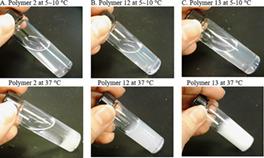当前位置:
X-MOL 学术
›
J. Appl. Polym. Sci.
›
论文详情
Our official English website, www.x-mol.net, welcomes your feedback! (Note: you will need to create a separate account there.)
Narrow molecular weight margins for the thermogelling property of polyester–polyether block copolymers in aqueous solutions
Journal of Applied Polymer Science ( IF 3 ) Pub Date : 2019-11-08 , DOI: 10.1002/app.48673 John Garner 1 , Justin Hadar 1 , Sarah Skidmore 1 , Faye Jessmon 1 , Rebecca Immel 1 , Amie Tyler 1 , Kinam Park 1, 2
Journal of Applied Polymer Science ( IF 3 ) Pub Date : 2019-11-08 , DOI: 10.1002/app.48673 John Garner 1 , Justin Hadar 1 , Sarah Skidmore 1 , Faye Jessmon 1 , Rebecca Immel 1 , Amie Tyler 1 , Kinam Park 1, 2
Affiliation

|
Polyester–polyether block copolymers with thermogelling properties have been widely used in pharmaceutical and biomedical applications for their biocompatibility and degradation to nontoxic components. The biodegradable polymers, such as poly(lactide‐co‐glycolide) and poly(lactide‐co‐caprolactone) (PLCL), have been used as the polyester block. The most commonly used polyether has been poly(ethylene glycol) (PEG). The thermogelling polymers dissolve in cold water, but become a semisolid gel at higher temperatures, for example, body temperature. This thermogelling property, however, occurs only within very narrow molecular weight ranges of the polyester at given polyether blocks. Only a few hundred Dalton differences in the polyester block can turn a thermogelling polymer into a water‐insoluble polymer. This study describes the hydrophilic and hydrophobic block sizes for endowing the thermogelling property and a simple, water‐free, synthesis of new thermogelling PLCL–PEG–PLCL triblock polymers. © 2019 Wiley Periodicals, Inc. J. Appl. Polym. Sci. 2020, 137, 48673.
中文翻译:

水溶液中聚酯-聚醚嵌段共聚物的热胶凝性能的窄分子量裕度
具有热胶凝性能的聚酯-聚醚嵌段共聚物因其生物相容性和降解成无毒成分而被广泛用于药物和生物医学领域。可生物降解的聚合物,例如聚(丙交酯-共-glycolide)和聚(丙交酯-共己内酯)(PLCL)已用作聚酯嵌段。最常用的聚醚是聚(乙二醇)(PEG)。热胶凝聚合物溶解在冷水中,但在较高的温度(例如体温)下变成半固体凝胶。然而,在给定的聚醚嵌段下,这种热胶凝性能仅在聚酯的非常窄的分子量范围内发生。聚酯嵌段中仅有几百道尔顿的差异才能将热胶凝聚合物转变为水不溶性聚合物。这项研究描述了赋予热胶凝性能的亲水性和疏水性嵌段大小,以及新型的热胶凝PLCL–PEG–PLCL三嵌段聚合物的简单,无水合成方法。分级为4 +©2019 Wiley Periodicals,Inc.J.Appl。Polym。科学 2020,137,48673。
更新日期:2020-03-26
中文翻译:

水溶液中聚酯-聚醚嵌段共聚物的热胶凝性能的窄分子量裕度
具有热胶凝性能的聚酯-聚醚嵌段共聚物因其生物相容性和降解成无毒成分而被广泛用于药物和生物医学领域。可生物降解的聚合物,例如聚(丙交酯-共-glycolide)和聚(丙交酯-共己内酯)(PLCL)已用作聚酯嵌段。最常用的聚醚是聚(乙二醇)(PEG)。热胶凝聚合物溶解在冷水中,但在较高的温度(例如体温)下变成半固体凝胶。然而,在给定的聚醚嵌段下,这种热胶凝性能仅在聚酯的非常窄的分子量范围内发生。聚酯嵌段中仅有几百道尔顿的差异才能将热胶凝聚合物转变为水不溶性聚合物。这项研究描述了赋予热胶凝性能的亲水性和疏水性嵌段大小,以及新型的热胶凝PLCL–PEG–PLCL三嵌段聚合物的简单,无水合成方法。分级为4 +©2019 Wiley Periodicals,Inc.J.Appl。Polym。科学 2020,137,48673。

























 京公网安备 11010802027423号
京公网安备 11010802027423号